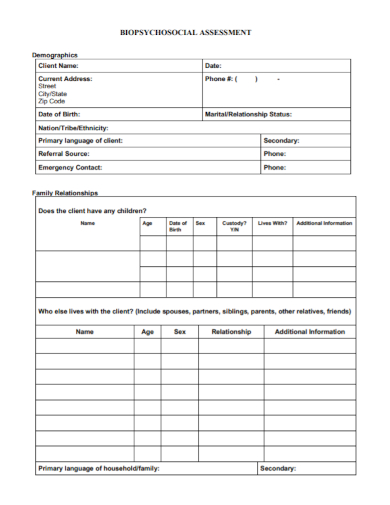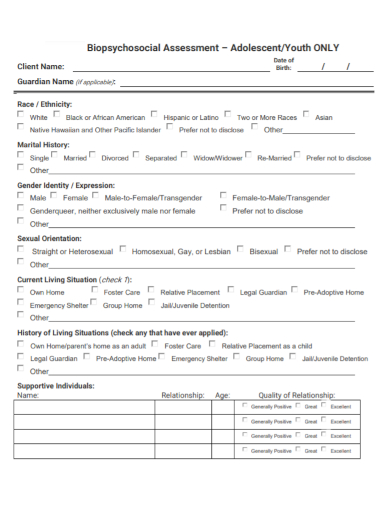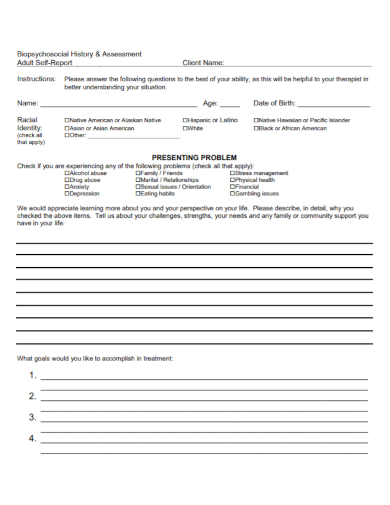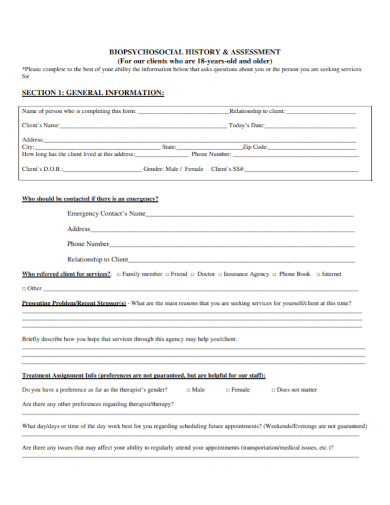The biological, social, and psychological variables that determine a person’s well-being are all interconnected in Engel’s model. To put it another way, a person’s body and mind are not two distinct entities. A patient may get depressed or nervous if they are suffering from a physical disease and lack social support. Similarly, someone suffering from depression may withdraw from friends and family and ignore self-care, thus harming their physical and social well-being. Mental health practitioners understand the importance of taking a holistic approach to clients and considering how numerous parts of their lives can influence to a mental health problem, hinder functioning, or perpetuate a disorder.
10+ Biopsychosocial Assessment Form Samples
A Biopsychosocial Assessment is a test that therapists and counselors use at the start of therapy to look for physiological, psychological, and social aspects that may be influencing to a customer issue or difficulties. It’s a comprehensive assessment that considers a client’s culture, experience, and work history, as well as family and marriage concerns and medical challenges, in order to better understand their needs. Counselors, social workers, and other mental health professionals can use a biopsychosocial assessment to learn more about their clients on several levels and better comprehend their subjective perspectives. As a result, biopsychosocial exams help therapists accurately diagnose their clients more successfully.
1. Client Biopsychosocial Assessment Form
2. Biopsychosocial Demographic Assessment Form
3. Youth Biopsychosocial Assessment Form
4. Biopsychosocial Assessment Form
5. Adult Biopsychosocial Assessment Form
6. Biopsychosocial History Assessment Form
7. Biopsychosocial Spiritual Assessment Form
8. Sample Biopsychosocial History Assessment Form
9. Adolescent Biopsychosocial Assessment Form
10. Patient Biopsychosocial Assessment Form
11. Biopsychosocial Psychiatric Assessment Form
As part of the initial examination with clients, mental health practitioners regularly perform a biopsychosocial assessment. If you want to understand more about your clients through biopsychosocial evaluations, we have resources to assist you get started. We’ll look at the components of a biopsychosocial assessment, as well as interviewing clients and how to construct a report, in this post. Psychological considerations, biological factors, and social aspects are three components of the biopsychosocial paradigm. As you collect data for your assessment through patient forms and face-to-face interviews, keep these elements in mind.
You can prepare a biopsychosocial assessment report after you’ve compiled information about your client. Your report will assist you in developing an appropriate treatment plan for your client as a full person. To coordinate care, you can also discuss your evaluation with colleagues or physicians.
Begin your report with some basic client information. This should consist of:
- Involve personally identifiable information about your client, such as their name, gender, date of birth, and civil status.
- Just provide name of the person or organization who recommended the client to you, as well as the type of help they were looking for.
- Describe the situation that brought the client to you. Include the client’s explanation of their condition, the length of time they’ve had it, and what they hope to achieve from your services. Also, explain what the client has tried in the past to remedy the problem.
FAQs
What do you mean by family history?
Describe the client’s family members, including childhood relationships and who they grew up with. List any history of substance misuse, legal issues, or psychiatric disorders among family members.
How do you input client’s appearance in the form?
Add any indicators of anxiety or sadness, as well as any memory or speech impairments, that your client displayed throughout the interview. If you conducted a mental status test during your initial visit with a client, include it in this section.
What are some of the tips to remember when writing a biopsychosocial assessment?
Create a balance of information: The goal of a biopsychosocial assessment is to assist you understand your client by illuminating the current condition. Make sure your report includes a balanced combination of valuable information, such as the client’s strengths and challenges, facts and impressions, and data from multiple sources, if possible, to generate a useful review.
If you want to see more samples and formats, check out some biopsychosocial assessment samples and templates provided in the article for your reference.
Related Posts
Agreement Form Samples & Templates
Vehicle Inspection Forms Samples & Templates
Sample Employee Advance Forms
Sample Child Travel Consent Forms
Sample Testimonial Request Forms
Sample Employee Details Forms
Sample Divorce Forms
Sample Attestation Forms
Employee Performance Appraisal Form Templates
FREE 9+ Sample Presentation Evaluation Forms in MS Word
FREE 10+ School Admission Form Samples & Templates in MS Word | PDF
FREE 30+ Patient Consent Form Samples in PDF | MS Word
FREE 10+ Sample Sign Off Form Templates in PDF | MS Word
FREE 11+ Sample Medical Consultation Forms in PDF | MS Word
FREE 8+ Sample Donation Forms in PDF | MS Word











